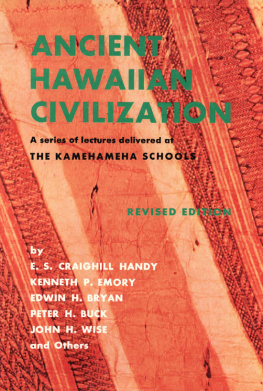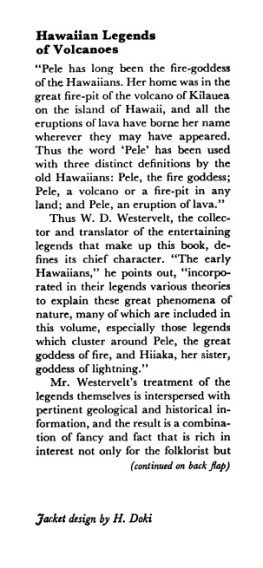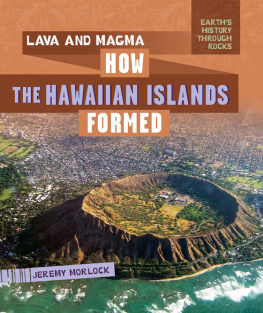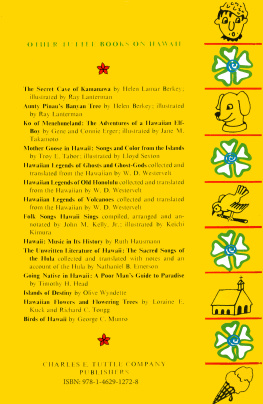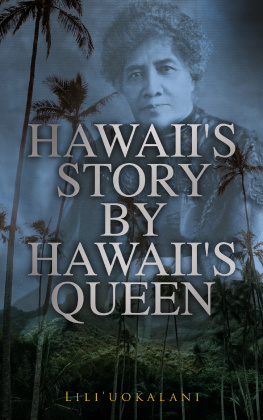ABOUT THE AUTHORS
E. S. Craighill Handy, Ph.D., is an ethnologist and has been with Bernice P. Bishop Museum since 1920. After making two expeditions to Tahiti and the Marquesas, Dr. Handy has, since 1930, actively concerned himself with Hawaiian ethnology, particularly with the fundamental aspects of Hawaiian culture and natural history. Field trips throughout Hawaii and the central South Pacific have given him practical experience in these studies. From 1935 to 1937 he served as Bishop Museum Visiting Professor at Yale. After World War II, he continued field research, particularly in the Ka u area of Hawaii, where his collaborator, Mary Kawena Pukui was born, but also in especially chosen localities of ecological interest on Oahu, Maui and Kauai. The results of these studies will be presented in bulletins of the Bishop Museum entitled The Hawaiian Planter, and Native Hawaiian Therapeutics. A description of the Hawaiian Family was published in a special publication of The Polynesian Society in Wellington, New Zealand in 1958.
Edwin H. Bryan, Jr., is Curator of Collections, Bernice P. Bishop Museum. Close associations, with the Museum's collection and with distinguished scientists working upon them, has given Dr. Bryan a good opportunity to view many aspects of Hawaiian ethnology and natural history. Field trips throughout Hawaii and the Central Pacific have given him practical experience in these studies. During World War II, Dr. Bryan served with the United States Army Intelligence. Following the war he served with various reconstruction agencies. Utilizing the knowledge and materials obtained during this period he established the Pacific Science Information Center and became its manager. He is the author of seven books and over three hundred scientific and popular articles.
Mrs. Lahilahi Webb was Guide to the Exhibits, Bernice P Bishop Museum. A friend, companion, and nurse to the late Queen Liliuokalani, Mrs. Webb lived an active life in surroundings especially favorable for acquiring a knowledge of Hawaiian history, lore, and culture. She has answered the questions of many thousands of visitors to the Museum.
Peter H. Buck,* M.D. (Te Rangi Hiroa) was an ethnologist and later Director (1936-51) of the Bernice P. Bishop Museum. Dr. Buck was a distinguished Maori. Humanitarian impulses led him into the field of medicine. He served during World War I as a major in the medical corps with Maori troops. As a medical officer in New Zealand, he found that a knowledge of native culture was essential as a direct means of serving his people. He received the Rivers Medal from the Royal Anthropological Institute of London in 1936. He was a life member of the Polynesian Society and a Fellow and life member of the Royal Society, both of New Zealand. In 1946 he was knighted a Knight Commander of St. Michael and St. George. He has earned other honors including degrees at colleges and universities in England and America, has participated in many scientific expeditions, and has authored books and articles of scientific importance.
Kenneth P. Emory is an anthropologist who has been with the Bernice P. Bishop Museum since 1920. He has written reports on the archaeology of Haleakala, Lanai, Nihoa, Necker, and on important sites of Oahu and Hawaii. Since writing the chapters in this book he has been on successive expeditions into many other islands of Polynesia and to two Polynesian-inhabited islands in Micronesia: Kapingamarangi and Nukuoro. He has published reports on the research carried out in those areas. He is now directing an extensive archaeological program of research in several primary areas of Polynesia in an effort to determine the origins of the Polynesian people and their culture, and in particular the last homeland or homelands of the Hawaiians.
Albert F. Judd* was the President of the Board of Trustees, Bernice P. Bishop Museum. The eldest son of the distinguished advisor of Hawaiian royalty, he was familiar with many aspects of Hawaii, its people and natural history. His extensive knowledge of Hawaiian and ornamental plants is shown by the valuable arboretum which he assembled on the new Kamehameha School grounds. Mr. Judd made several scientific expeditions to Samoa on behalf of the Bishop Museum. He was a Trustee of the Bernice P. Bishop Estate and chairman of the Committee of the Frederic Duclos Barstow Foundation.
Huc M. Luquiens* was professor of art at the University of Hawaii. His interest in ancient Hawaiian culture from the standpoint of art has expressed itself in his valuable monograph on Hawaiian art.
John H. Wise* in the years following graduation from Oberlin College, became a recognized authority on Hawaiian language and lore. He was co-author of a textbook in Hawaiian language and was a general consultant concerning Hawaiian landholdings, water rights, and customs. He served as Territorial senator on special missions to Washington D. C., and for many years served on the faculty of the Kamehameha Schools.
Thomas Maunupau* was the son of the Chief of Kalakaua's fisheries. He was in the office of the Territorial Bureau of Conveyances and come to be regarded as an expert on fishing rights and land matters.
Reverend Henry P. Judd* served in many church-related capacities in Hawaii notably as Secretary of the Hawaiian Evangelical Association. He also was considered an authority on the Hawaiian language and published a textbook which has been issued in many editions. He also was author of many Bishop Museum publications on the Hawaiian language.
Jane Lathrop Winne taught music as a member of the faculty of Punahou School from 1916-43. During these years she was one of the outstanding researchists in the music of ancient Hawaii and also accomplished much original work in that area.
Edith Rice Plews and Juliet Rice Wichman are the granddaughters of the late Honorable William Hyde Rice of Kauai. From their grandfather, who was a sincere student of things Hawaiian, and from many old Hawaiian friends and kamaainas, they have gathered a very valuable and authoritative fund of knowledge, especially in their respective fields of poetry and agriculture, and have generously made their findings available to modern students through their numerous publications.
Nils P. Larsen* was medical director of The Queen's Hospital in Honolulu. He wos editor of the Queen's Hospital Bulletin and author of many important studies, particularly in the fields of asthma and pneumonia. He was largely responsible for the Class A rating of the Queen's Hospital by the American Medical Association. He formerly instructed in medicine at Cornell University. In Hawaii, he has cooperated with and supported a wide range of medical studies, including studies of ancient Hawaiian medicine and food. He has served in numerous leadership capacities in Honolulu community activities.
Charles H. Edmondson, Ph.D., a distinguished scientist, has recently retired as professor of Zoology at the University of Hawaii, as Director of the Beach Laboratory of the University of Hawaii at Waikiki, and as Marine Zoologist of the Bernice P. Bishop Museum. He has carried on extensive research of the growth of corals and life on the coral reef, a popular account of which was published by the Bishop Museum. He is the author of many publications of the Museum and the University.
Harold S. Palmer,* Ph.D., was professor of geology at the University of Hawaii. He was the author of several studies in the geology of these islands and served as engineering and geologic consultant in water matters.
Footnote
Deceased
"Books to Span the East and West"
HAWAII'S STORY BY HAWAII'S QUEEN by Liliuokalani

